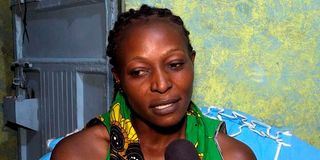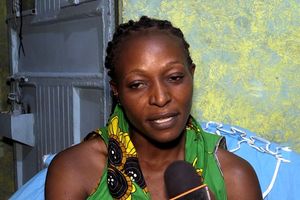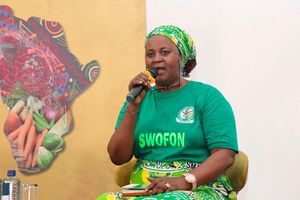
Mellen Mogaka, the woman assaulted in Nyamira, during the burial of her ex-husband speaks out about the ordeal at her home in Narok town, on March 24.
I am a student of culture; it is what I was called to study at the University of Nairobi many years ago.
At that time, no one in my village prefecture knew what anthropology was – some confused it with the study of insects, while many others concluded that whatever it was, I would amount to nothing with it; and subtly advised I institute a career change immediately I set foot at the fountain of knowledge.
I stuck to that age-old paint advert, that when you’re in need of a clear view of anything, you will never gone wrong when you ask the experts.
Cultural experts will tell you that whatever happened to that grieving widow in the Kisii highlands this week was abhorrent and detestable. Prof Collette Suda – who once served as the Principal Secretary for Higher Education – was my lecturer at the Institute of Anthropology and Gender Studies.
She taught us a critical compulsory course in Fourth Year, aptly named Culture Change and Development.
For the benefit of those who only see anthropology at the National Museums of Kenya, culture is a shared system of beliefs, values, norms and tradition that distinguishes one group of people from another.
Broadly speaking, culture can be categorized into two broad classifications; material culture (these are physical objects created by adherents of a particular culture to denote their authenticity and uniqueness – like dress codes, housing designs, tools of trade, and even food systems) and non-material culture (consisting of normative ideas, value systems, traditional beliefs, and other customs passed on through oral literature, art and even religion).
You will have to bear with me as we build this test case, because we live in a country where words are overly analysed and meanings are often lost through translation.
To better understand what culture means to those rooted in its practice, it is critical to appreciate that culture is the lifeblood of any vibrant society without which we would be barren in morality, hollow in ideology, and directionless in trajectory. In addition to being the driving force to our behaviour, culture also plays a critical role in influencing our attitudes towards those who do not practice our belief systems.
By immersing ourselves in our own uniqueness, culture not only helps us define who we are, but also helps us see the world through the eyes of others.
To this end, there is appreciation that no single individual can abandon their own set of value systems and still claim authenticity among practitioners of their respective culture. It is what binds them together with their ancestors long gone, and sustains their culture long after they will have left.
However, every traditional culture – regardless of their diversity – are bound a specific set of ten characteristics which anthropologists world over are in consensus to be universal. All cultures are; shared, learned, symbolic, integrated, dynamic, adaptive, diverse, gratifying, abstract, and facilitates communication.
Of the ten pinpoint characteristics highlighted above, the Institute of Anthropology and Gender Studies at the University of Nairobi, out of their scientific wisdom – and for good measure – designed a specific unit aimed at immersing all early career anthropologists on the attribute that speaks to the dynamism of culture.
Culture Change and Development as a course unit, therefore, not only emphasized the fact that culture is not static – as custodians of culture down in the villages would want us to believe – but it also envisioned a world where there would be need for the cultures that we practice to evolve with the changing times in order for us to remain competitive in a fast paced world.
There is no doubt that the funeral rites among the Abagusii community required a newly-minted widow undergo certain sacramental processes to appease the spirits of their ancestors and guarantee her total acceptance and continuity in the home of her in-laws.
Anthropology preaches in support of cultural relativism – the ideology that every belief system should be judged on the context of the particular culture it originates from and no culture is absolute and more superior to the other.
However, for a specific culture to be adaptive; it must, as a matter of principle, shed off traditional baggage that no longer serves its intended purpose of restoring pride and identity among those that practice it. When practitioners of a particular set of cultural norms begin to hurt in their practice of those specific attributes, then anthropology advises that that’s the earliest red alert the specific cultural appendix deserves to be taken through the surgical board.
Evolutionary biologists will tell you of a certain French scholar called Jean-Baptiste Lamarck who came up with the revolutionary theory loosely christened ‘use-and-disuse of parts’. Lamarck’s works are a required reading in Anthropology school for his insights into the evolution of cultures and adaptation of cultural societies.
The theory simply advances the narrative that when certain organs in your body become underutilized over a period of time, the utility of those organs begin to diminish and consequently become vestigial, then that state becomes hereditary and can be passed on to your progeny.
He goes on to give the example of the body organ called the coccyx – that small triangular bone at the base of your spinal column that used to act as the fulcrum of the tail when human beings were still evolving from the planet of the apes.
Many examples abound of cultural practices that have since died a natural death or panel-beaten to change with the times, all in the spirit of maintaining relevance and remaining globally competitive.
Culture is dynamic because all cultures are bound to change over time out of response to acculturation; which is the exposure to and eventual emulation of the objects of one culture by another culture perceived to be more in tune with the signs of the times.
There remains no justification to the clinging onto certain tenets of a particular culture when all the indicators have started flashing red. Whatever happened in the Gusii highlands last weekend should awaken the conscience of all cultural gatekeepers to rewrite our traditional laws to reflect cultural norms that embrace humanity in the face of grief.
gabriel.oguda@hotmail.com








